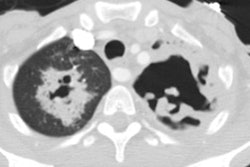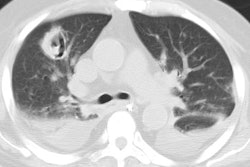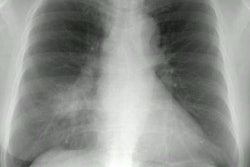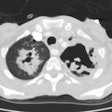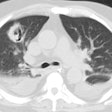Hanta Virus:
Clinical:
Hanta virus is a rare rodent borne (deer mouse) single-stranded RNA viral pathogen [3,4]. The virus is transmitted via inhalation of aerosolized virus particles from wild rodent (deer mouse) urine, saliva, or dried excreta [3,4]. Human-to-human transmission has not been recorded [3]. Hanta virus pulmonary syndrome results from infection by the Sin Nombre virus species of the Hantavirus genus. Hanta virus infection causes an immune-mediated capillary leak leading to hypovolemia, hemoconcentration, and shock. Mortality is greater than 40%. Confirmation of the diagnosis requires a viral-specific antibody test [3].Two types of presentations have been described- one form is associated with fulminent clinical and radiographic findings (non-cardiogenic pulmonary edema) which requires intensive care support and is associated with a high mortality; the other presentation is associated with only mild pulmonary and radiographic findings and no mortality [3]. All patients with the limited form of the infection survive, while death occurs in about 50% of cases with the fulminant infection [3,4].
After an incubation period of 9-35 days, Hanta virus pumonary syndrome progresses through 3 stages [3]. The initial stage is the prodromal phase, which is followed by the cardiopulmonary and convalescent phases. The prodromal phase consists of nonspecific symptoms such as myalgia, fever, headache, cough, shortness of breath, and diarrhea [3]. Symptoms of an upper respiratory infection (rhinorrhea, sore throat, or nasal congestion) are uncommon [3]. The prodromal phase usually lasts 3 to 6 days [3]. Most cases then rapidly progress to the cardiopulmonary phase [3]. Features include a rapid clinical decompensation with hypotension and respiratory insufficiency [3]. If the patient survives this phase, they then enter the convalescent phase with rapidly improveing oxygenation, hemodynamic stabilization, and diuresis [3].
X-ray:
CXR may initially be normal, but rapidly worsens [5]. Interstitial edema (Kerley lines and bronchial wall thickening) and pleural effusions are common during the early stages of the infection. Airspace disease develops rapidly and concentrates in the central and basal zones- it is usually accompanied by respiratory failure.Patients with limited Hanta virus syndrome demonstrate interstitial edema and minimal airspace infiltrates [3].
(1) J Thorac Imaging 1998; Ketai LH, Godwin JD. A new view of pulmonary edema and acute respiratory distress syndrome. 13: 147-171
(2) J Thorac Imaging 1998; Ketai LH, et al. Distinguishing hantavirus pulmonary syndrome from acute respiratory distress syndrome by chest radiography: Are there different radiographic manifestations of increased alveolar permeability? 13: 172-177
(3) AJR 2002; Boroja M, et al. Radiographic findings in 20 patients with Hantavirus pulmonary syndrome correlated with clinical outcome. 178: 159-163
(4) Radiographics 2002; Kim EA, et al. Viral pneumonias in adults:
radiologic
and pathologic findings. 22: S137-S149
(5) Radiology 2011; Franquet T. Imaging of pulmonary viral pneumonia. 260: 18-39
